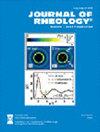金属超分子聚合物基质中稀释的动态共价网络的平衡动力学
IF 3.2
2区 工程技术
Q2 MECHANICS
引用次数: 1
摘要
研究了基于侧功能化pnba链的双动态网络(DDNs)的粘弹性性质。其中一个网络是由金属配体连接高度交联的,其特征是快速的结合/解离动力学,而另一个网络是由缓慢的动态共价网络(DCNs)稀疏交联的。我们首先表明,通过调节温度、可逆结的密度或施加的应力来调节金属超分子网络的动力学,对DCN的局部平衡有直接的影响。后者在金属配体连接的结合/解离的节奏下通过约束释放劳斯过程发生。然后,基于蠕变-恢复实验,我们研究了DDNs在蠕变试验后恢复其初始形状的能力,并再次证明了金属超分子网络在蠕变试验中的重要作用。特别是,样品的恢复很大程度上取决于网络的连通性,如果使用更致密的金属超分子网络,则可以增强网络的连通性,因为它减少了双动态网络可能发生的蠕变并增加了其弹性记忆。样品恢复还取决于金属超分子键的结合-解离动力学,因为它确定了拉伸DCN恢复其平衡构象的速度,以及在施加大变形后恢复其初始形状的速度。因此,调节弱网络的动力学是控制慢网络粘弹性响应的关键过程。本文章由计算机程序翻译,如有差异,请以英文原文为准。
Equilibration dynamics of a dynamic covalent network diluted in a metallosupramolecular polymer matrix
We investigate the viscoelastic properties of double dynamic networks (DDNs) based on side-functionalized P nBA chains. One of these networks is highly crosslinked by metal-ligand junctions characterized by a fast association/dissociation dynamics, while the other network is sparsely crosslinked with slow dynamic covalent networks (DCNs). We first show that modulating the dynamics of the metallosupramolecular networks, by playing with the temperature, the density of reversible junctions, or the stress applied, has direct consequences on the local equilibration of the DCN. The latter takes place by a constraint release Rouse process at the rhythm of the association/dissociation of the metal-ligand junctions. Then, based on creep-recovery experiments, we investigate the ability of the DDNs to recover their initial shape after a creep test and show again the important role played by the metallosupramolecular network. In particular, the sample recovery strongly depends on the network connectivity, which is enhanced if a denser metallosupramolecular network is used as it reduces the possible creep of the double dynamic network and increases its elastic memory. The sample recovery also depends on the association-dissociation dynamics of the metallosupramolecular bonds as it fixes how fast the stretched DCN can come back to its equilibrium conformation and can recover its initial shape after a large deformation has been applied. Adjusting the dynamics of the weak network is thus a key process to govern the viscoelastic response of the slow network.
求助全文
通过发布文献求助,成功后即可免费获取论文全文。
去求助
来源期刊

Journal of Rheology
物理-力学
CiteScore
6.60
自引率
12.10%
发文量
100
审稿时长
1 months
期刊介绍:
The Journal of Rheology, formerly the Transactions of The Society of Rheology, is published six times per year by The Society of Rheology, a member society of the American Institute of Physics, through AIP Publishing. It provides in-depth interdisciplinary coverage of theoretical and experimental issues drawn from industry and academia. The Journal of Rheology is published for professionals and students in chemistry, physics, engineering, material science, and mathematics.
 求助内容:
求助内容: 应助结果提醒方式:
应助结果提醒方式:


